You can secure your wearable health data by implementing end-to-end encryption for all transmissions and enabling multi-factor authentication on your devices. Configure biometric security features like fingerprint or heart rate verification, establish granular privacy controls to limit data sharing, and maintain regular firmware updates. Additionally, secure your healthcare platform integrations, implement role-based access controls if you’re medical staff, monitor device access logs regularly, and stay educated on evolving security threats. These thorough strategies will help you protect your most sensitive health information from cyber threats.
Implement End-to-End Encryption for Health Data Transmission
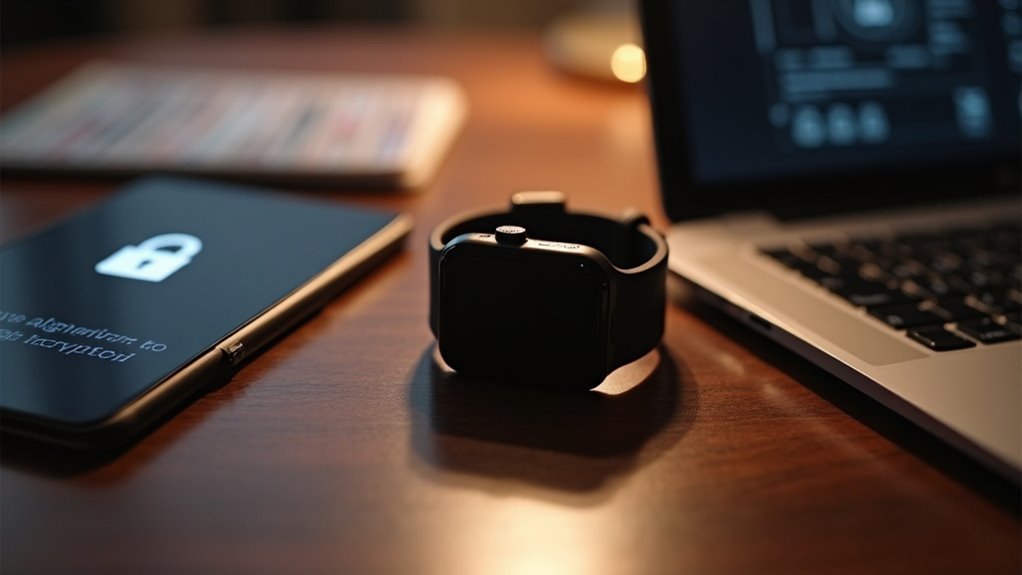
When you’re transmitting sensitive health data from your wearable device, end-to-end encryption serves as your first line of defense against unauthorized access and data breaches. This technology guarantees your data remains encrypted throughout its entire journey from your device to its destination, making it nearly impossible for interceptors to access without proper decryption keys.
You’ll need to implement secure protocols like HTTPS for data transmission while guaranteeing your encryption standards meet regulatory requirements such as HIPAA and GDPR.
Focus on encrypting data both in transit between devices and at rest when stored on servers. Your wearable apps should utilize crypto APIs to establish secure communication channels, protecting sensitive health information from potential threats during transmission to cloud services or healthcare providers. Additionally, ensure that sensitive keys for accessing health records are never stored in plain text, as this critical security measure prevents unauthorized access even if systems are compromised.
Enable Multi-Factor Authentication for Device Access
Beyond securing data transmission, you must protect the initial access point to your wearable device itself through multi-factor authentication (MFA). This security layer combines multiple credential categories—what you know, have, and are—making unauthorized access considerably more difficult.
| Authentication Factor | Examples | Implementation |
|---|---|---|
| Knowledge | Passwords, PINs | Device codes, OAuth 2.0 |
| Possession | Smartphones, tokens | Mobile authenticator apps, QR codes |
| Inherence | Fingerprints, ECG | Behavioral biometrics, physiological data |
MFA protects your sensitive health data from credential theft and phishing attacks while ensuring compliance with healthcare regulations. You’ll need to reflect on potential challenges like device dependency—if you lose your smartphone, you might lose access to your authentication method. Choose hybrid approaches that balance security with usability for your specific health monitoring needs. Device code authentication provides an effective alternative that eliminates the need to speak credentials aloud, enhancing security while maintaining user convenience.
Configure Biometric Security Features on Smartwatches
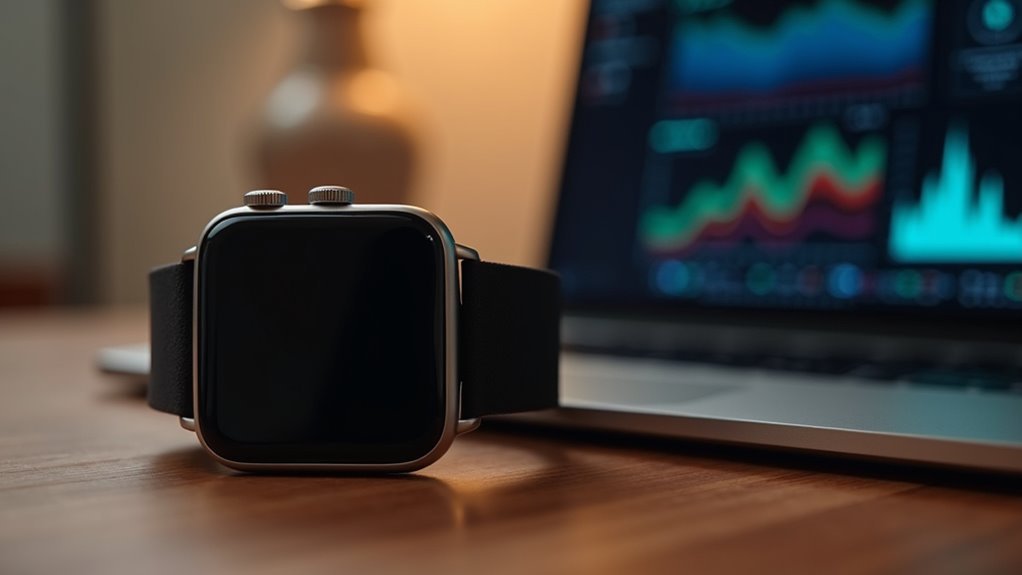
You can greatly enhance your smartwatch’s security by configuring multiple biometric authentication methods that protect your sensitive health data.
Setting up fingerprint authentication, face recognition, and heart rate verification creates layers of protection that make unauthorized access much more difficult.
These biometric features work together to guarantee that only you can access your personal health information while maintaining the convenience of quick, seamless authentication. Make sure to choose devices with robust encryption features that safeguard your biometric data during storage and transmission.
Enable Fingerprint Authentication
Two major advantages make fingerprint authentication the most practical biometric security option for smartwatches: it’s faster than typing PINs on tiny screens, and it’s more secure than traditional passwords.
Each fingerprint’s uniqueness provides unbreakable identification that can’t be guessed or stolen like traditional credentials.
You’ll find major manufacturers like Samsung partnering with PayPal to integrate advanced fingerprint sensors from companies like Synaptics.
These sensors use edge computing for real-time authentication, ensuring instant access to your health data and payment features.
Enable fingerprint authentication by accessing your smartwatch’s security settings and following the enrollment process.
This eliminates unauthorized access risks while streamlining your daily interactions.
The technology’s affordability makes it increasingly standard across devices, protecting your sensitive health information effortlessly. Research shows that biometric authentication is preferred by 53% of Americans over traditional passwords, demonstrating growing consumer confidence in this security method.
Set Up Face Recognition
Most smartwatches don’t offer native face recognition features, creating a significant limitation for users seeking extensive biometric security.
Since few wearable models include cameras necessary for face recognition, you’ll need to rely on alternative authentication methods and companion device integration.
Configure your smartwatch’s primary security using PIN, pattern, or password options. For enhanced protection, enable face recognition on your paired smartphone’s companion health apps.
When you access health data, you’ll authenticate through your phone’s biometric features rather than directly on the watch.
Ensure your companion health apps require biometric verification for data access. Update your smartphone’s operating system regularly and review app permissions to confirm proper biometric integration.
This layered approach compensates for your smartwatch’s face recognition limitations while maintaining robust health data security. Many health apps must comply with Wear OS App Quality Guidelines that establish security standards for wearable applications.
Configure Heart Rate Verification
Beyond traditional PIN and password methods, heart rate verification offers a unique biometric security layer that leverages your smartwatch’s built-in sensors.
You’ll enable continuous heart rate monitoring to establish your baseline patterns, creating a personalized security profile that’s difficult to replicate.
Configure irregular heart rhythm notifications to detect unauthorized access attempts that might cause physiological stress. These notifications utilize optical heart rate sensors to continuously monitor your cardiovascular patterns throughout the day.
Set up alert systems that notify you when heart rate patterns deviate considerably from your established norms, potentially indicating device tampering.
Integrate ECG app features for enhanced verification accuracy during sensitive data access.
Store this biometric data with robust encryption protocols to prevent unauthorized manipulation.
Enable secure syncing mechanisms to backup your heart rate verification settings while maintaining security integrity across connected devices.
Establish Granular Privacy Controls and Data Permissions
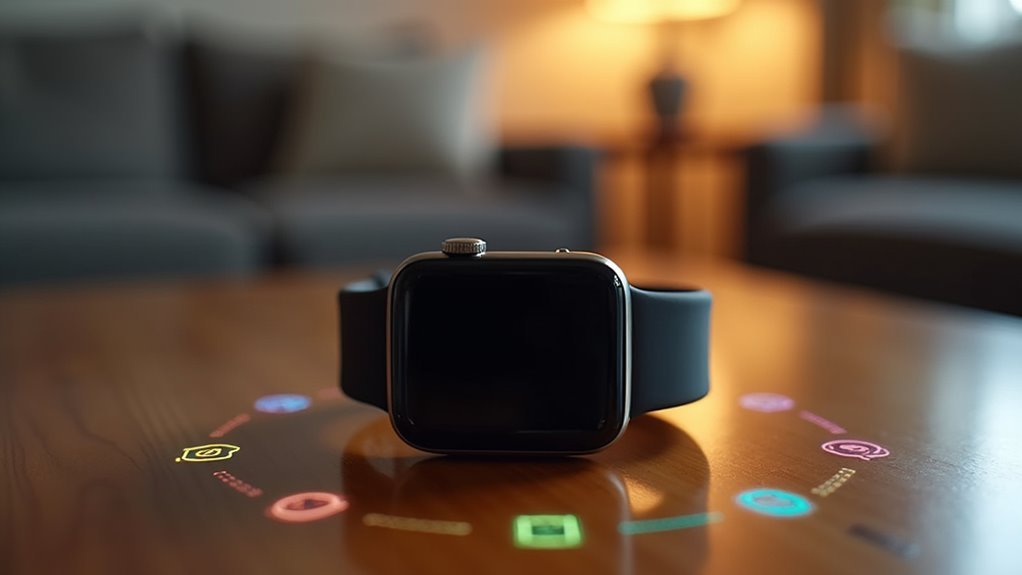
When wearable devices collect your sensitive health information, you need thorough control over who accesses that data and how it’s used. Establish granular privacy controls by implementing data access systems that let you manage permissions for apps and devices, ensuring only necessary information gets shared.
You should have selective sharing options with healthcare providers and other authorized parties, plus informed consent mechanisms before any data collection occurs.
Implement a robust data permissions framework using role-based access controls and encrypted data storage. Regular auditing helps detect potential breaches while compliance with regulations like GDPR and HIPAA protects your rights.
Enhance your control through opt-in features, data deletion options, and portability tools. Multi-factor authentication adds security layers, while data anonymization and pseudonymization techniques protect your identity even when information gets analyzed. Given the projected global market growth to USD 256.4 billion by 2026, establishing these privacy controls becomes even more critical as wearable technology adoption accelerates.
Maintain Regular Firmware and Software Updates
While establishing robust privacy controls forms your first defense against data breaches, keeping your wearable device’s firmware and software current provides another critical layer of protection for your health information.
Regular updates patch known security vulnerabilities that cybercriminals actively exploit. They guarantee your device complies with evolving regulatory standards and enables new security features to protect your sensitive data. Without updates, you’re leaving your device susceptible to malware injection and unauthorized access. Digital signatures ensure the authenticity of updates, preventing malicious injections during the update process.
Essential practices for maintaining secure updates include:
- Enable automatic updates to receive critical security patches promptly
- Verify update authenticity through trusted manufacturer channels only
- Monitor device behavior after updates for any operational anomalies
- Schedule regular update checks rather than waiting for breach notifications
- Prioritize security updates over feature enhancements when both are available
Deploy Real-Time Threat Monitoring Systems
As cybercriminals increasingly target health data on wearable devices, real-time threat monitoring systems provide essential protection by identifying suspicious activities the moment they occur. These systems use AI algorithms to analyze data flows continuously, detecting anomalies that could signal cyber attacks. When unusual patterns emerge—like unexpected data spikes or irregular transmission behaviors—the system immediately alerts healthcare providers for swift intervention.
| Monitoring Feature | Security Benefit |
|---|---|
| AI Pattern Analysis | Detects suspicious data flow anomalies |
| Real-Time Alerts | Enables immediate response to threats |
| Data Flow Tracking | Identifies irregular transmission patterns |
| Anomaly Detection | Flags unusual device behaviors instantly |
| Predictive Analytics | Anticipates potential security breaches |
You’ll need robust threat detection capabilities since over 60% of healthcare breaches involve data in transit, making continuous monitoring essential for protecting your wearable health information. The lack of standardized security protocols across different manufacturers creates additional vulnerabilities that real-time monitoring systems must address.
Secure Data Integration With Healthcare Platforms
Real-time monitoring provides the foundation for detecting threats, but securing the pathways where wearable data flows into healthcare platforms requires equally strong protection measures.
Real-time threat detection means nothing without equally robust security protecting the data pathways between wearables and healthcare systems.
You’ll need thorough integration strategies that protect data while maintaining seamless connectivity.
Establish secure transmission channels using these essential approaches:
- Implement standardized APIs like FHIR and HL7 protocols to guarantee structured, secure data exchange with Electronic Health Records while maintaining interoperability across different systems.
- Deploy encrypted communication protocols including TLS/SSL encryption and authenticated pairing processes to prevent unauthorized access during data transmission.
- Utilize power-efficient connectivity through Bluetooth Low Energy (BLE) for local transfers and secure Wi-Fi/cellular networks for remote monitoring capabilities.
- Apply data normalization techniques to standardize diverse wearable formats before integration, reducing vulnerabilities from inconsistent data structures.
- Maintain strict compliance frameworks adhering to HIPAA and GDPR regulations with role-based access controls. Consider leveraging unified APIs that can handle integrations from multiple wearable sources while maintaining these security standards throughout the data pipeline.
Implement Role-Based Access Controls for Medical Staff
Once secure integration channels are established, implementing role-based access controls (RBAC) becomes your next critical defense layer for protecting wearable health data within healthcare platforms.
RBAC restricts access based on defined user roles rather than individual identities, ensuring physicians, nurses, administrators, and IT specialists only access data necessary for their job functions.
You’ll reduce unauthorized access incidents by over 70% while maintaining HIPAA compliance.
Start by identifying all user roles and their specific data access needs. Define clear permissions for viewing, modifying, and managing wearable data, then integrate RBAC with existing EHR systems.
Regularly review role definitions as responsibilities evolve and train staff on their access rights. This approach streamlines workflows while minimizing human error through restricted high-risk actions. The continuous investment required for technological advancements makes role-based controls even more essential as facilities upgrade their wearable monitoring capabilities.
Audit and Monitor Device Access Logs
Beyond controlling who accesses your wearable health data, you must track and analyze every interaction with these devices through thorough audit logs.
This monitoring creates a security foundation that detects unauthorized access and guarantees regulatory compliance.
Your audit strategy should include:
- Centralized log storage with encryption to protect sensitive access records from tampering
- Real-time monitoring systems that trigger automated alerts when suspicious activity occurs
- Regular manual reviews by security personnel to catch anomalies automated systems might miss
- Data analytics tools that identify unusual access patterns and potential security breaches
- Scheduled extensive audits with documented findings to maintain HIPAA compliance
You’ll need clear log retention policies and restricted access controls to guarantee only authorized personnel can review these critical security records.
Given that wearable devices provide continuous data collection for comprehensive health monitoring, maintaining detailed audit trails becomes even more critical as the volume and sensitivity of captured health information increases exponentially.
Educate Users on Wearable Security Best Practices
You’re only as secure as your weakest security habit when using wearable devices that collect sensitive health data.
Understanding the most common threats like malware, phishing attacks, and data breaches helps you recognize vulnerabilities before they compromise your information. Since 61% of data breaches involve exploiting user credentials, maintaining strong authentication practices becomes critical for protecting your wearable device data.
Implementing essential protection practices such as strong passwords, regular updates, and careful app management creates multiple layers of defense for your personal health data.
Common Security Risks
While wearable devices offer incredible health monitoring capabilities, they’re also vulnerable to numerous security threats that can compromise your most sensitive personal information. Understanding these common risks helps you take appropriate protective measures.
Your wearable device faces several significant security vulnerabilities:
- Data manipulation attacks that can alter your health readings, potentially leading to incorrect medical decisions.
- Bluetooth and Wi-Fi interception where hackers capture transmitted data during wireless communication.
- Ransomware targeting that locks your device and demands payment for restoration.
- Weak password exploitation allowing unauthorized access to your stored health and financial information.
- Healthcare network breaches where compromised wearables become gateways for larger system attacks.
These threats can expose your location data, movement patterns, medical history, and even financial details stored on payment-enabled devices. Many wearable manufacturers lack transparency in their data collection practices, leaving users unaware of how their personal information is being gathered and used.
Essential Protection Practices
Protecting your wearable device requires a proactive approach that combines technical safeguards with smart user habits.
You’ll need to prioritize data privacy by ensuring devices offer strong encryption and multi-factor authentication before purchasing. Research security features thoroughly, read reviews, and compare products to assess their protection standards.
Choose devices designed with security from the outset, featuring regular software updates and multilayered protection approaches. Prioritize devices that implement automated patching capabilities to reduce vulnerability exposure through inherent security measures.
You should maintain control over your data through opt-in settings and deletion options. Stay informed about manufacturer guidelines and regulatory changes affecting wearable security.
Keep your device updated with the latest patches, enable real-time monitoring when available, and follow transparent data usage policies.
These practices create robust defense against cyber threats while maintaining your health information’s confidentiality.
Frequently Asked Questions
What Happens to My Health Data if My Wearable Device Gets Stolen?
If your wearable’s stolen, thieves can access unencrypted health data, personal identifiers, and location information. They might compromise your paired devices, cloud accounts, and even manipulate health readings, potentially causing identity theft or safety risks.
Can Insurance Companies Access My Wearable Health Data Without My Permission?
Insurance companies generally can’t access your wearable health data without explicit consent. However, you might’ve unknowingly agreed to data sharing through app permissions or insurance program sign-ups, so review your agreements carefully.
How Long Do Wearable Manufacturers Store My Personal Health Information?
Wearable manufacturers typically store your personal health information for varying periods, ranging from a few days to several years, depending on their specific policies and the type of data collected from your device.
Are There Specific Wearable Brands That Are More Secure Than Others?
Yes, Apple Watch leads with strong encryption and secure boot processes, while Garmin offers robust security after learning from past incidents. Fitbit provides decent protection but has faced privacy concerns previously.
What Should I Do if I Suspect My Wearable Data Has Been Compromised?
Immediately disconnect your wearable from Wi-Fi and Bluetooth, then power it down. Change passwords for all linked accounts, review connected services for unauthorized access, and report the breach to relevant authorities and manufacturers.
In Summary
You’ve now got the essential tools to protect your health data on wearables. Don’t wait—start implementing these security measures today. Update your device firmware, enable multi-factor authentication, and review your privacy settings. Remember, you’re responsible for safeguarding your personal health information. Stay vigilant about suspicious activity, keep learning about new threats, and regularly audit your device permissions. Your health data’s security depends on your proactive approach.

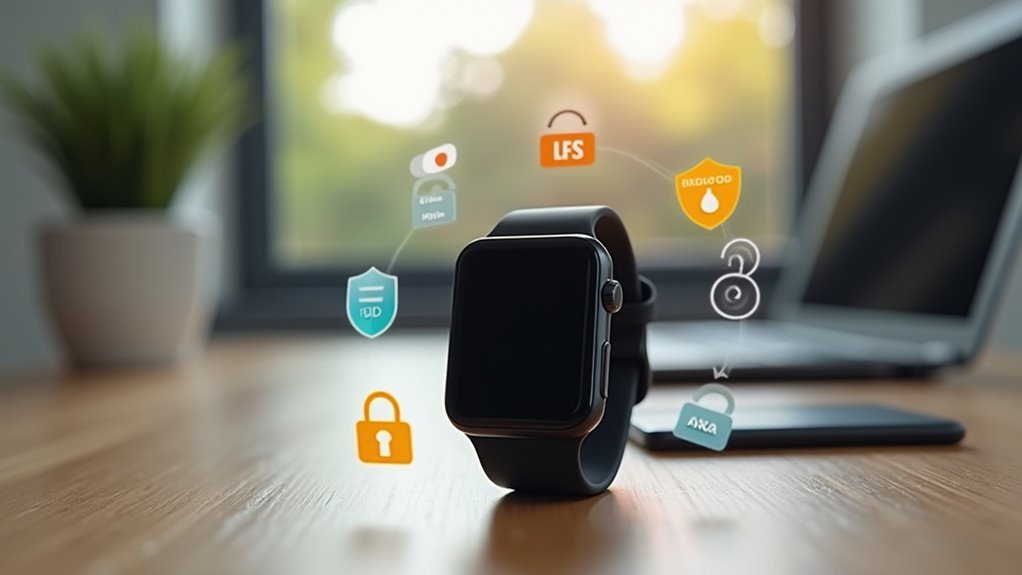
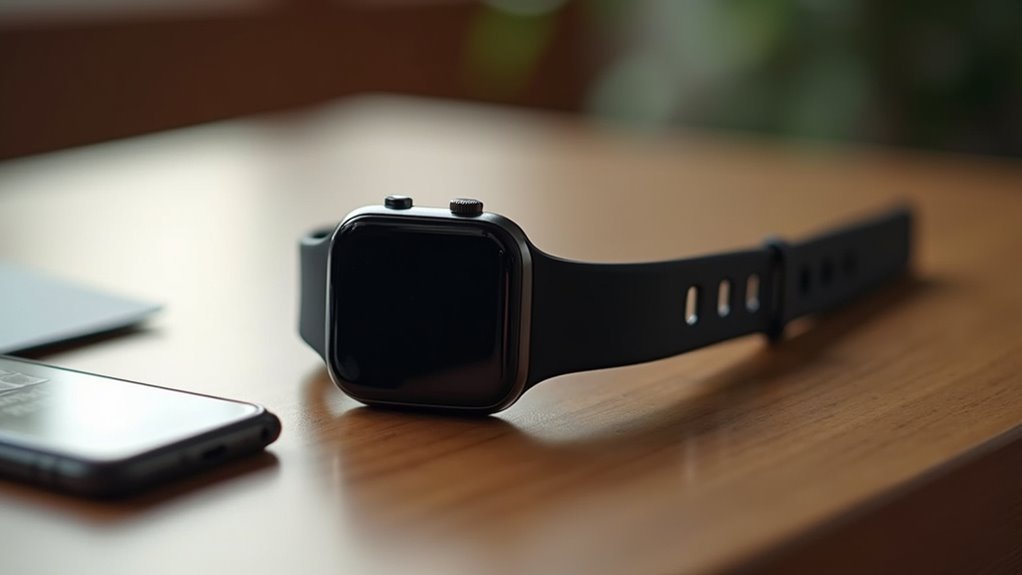
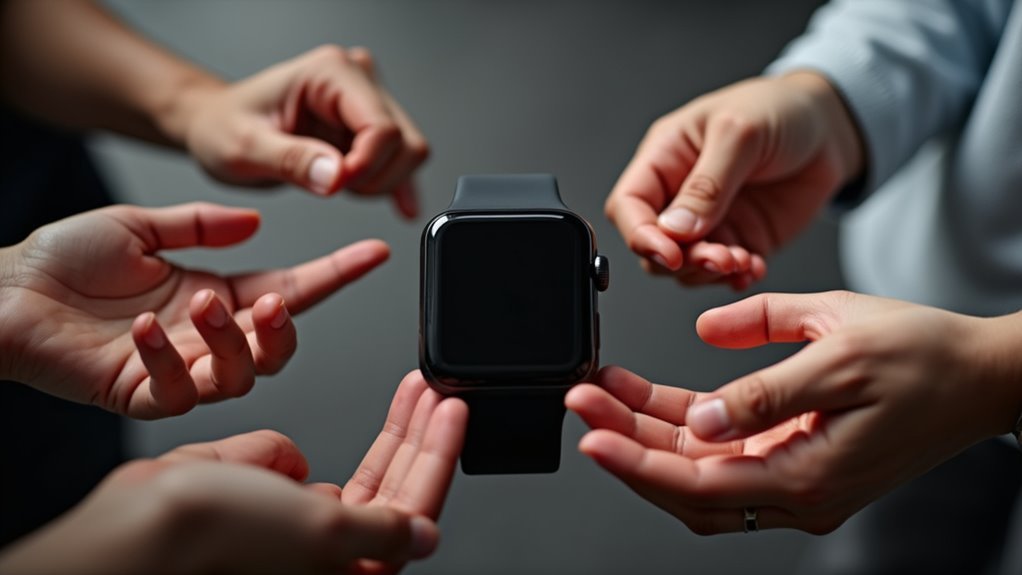
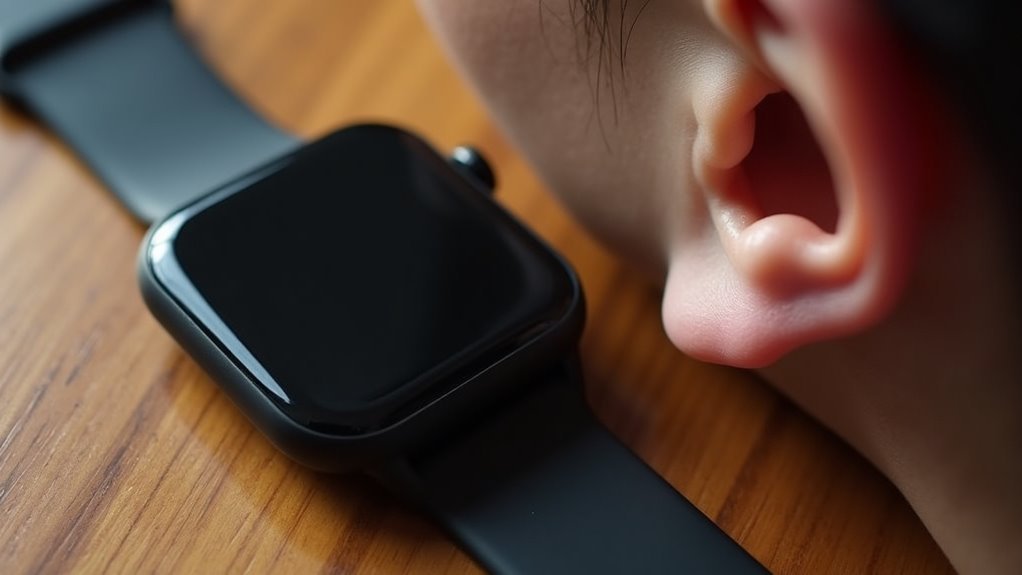
Leave a Reply